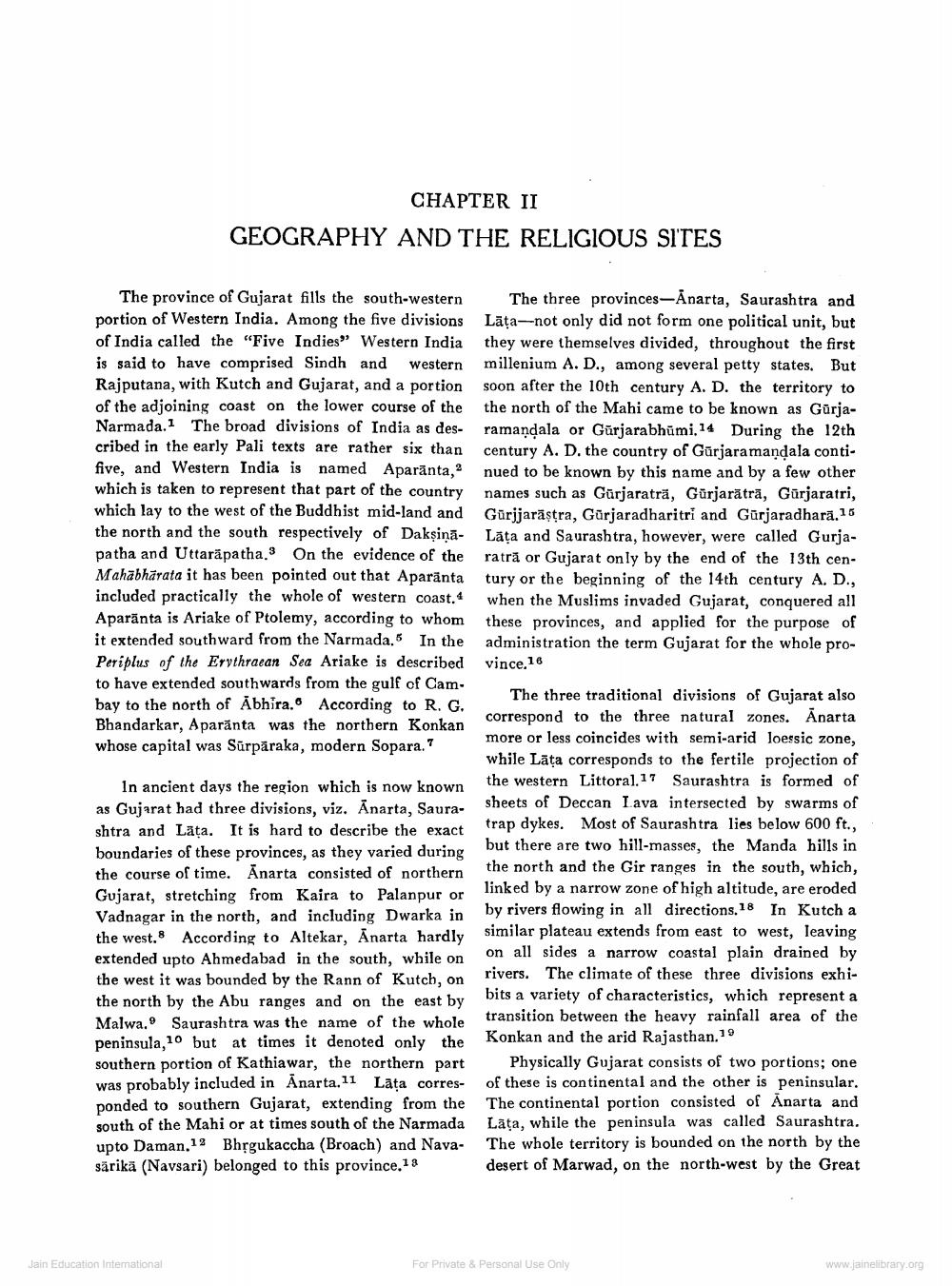________________
CHAPTER II
GEOGRAPHY AND THE RELIGIOUS SITES
The province of Gujarat fills the south-western The three provinces-Ānarta, Saurashtra and portion of Western India. Among the five divisions Lāța--not only did not form one political unit, but of India called the "Five Indies” Western India they were themselves divided, throughout the first is said to have comprised Sindh and Western millenium A. D., among several petty states. But Rajputana, with Kutch and Gujarat, and a portion soon after the 10th century A. D. the territory to of the adjoining coast on the lower course of the the north of the Mahi came to be known as GurjaNarmada. The broad divisions of India as des- ramandala or Gurjarabhūmi, 14 During the 12th cribed in the early Pali texts are rather six than century A. D. the country of Gurjara mandala contifive, and Western India is named Aparanta, 2 nued to be known by this name and by a few other which is taken to represent that part of the country names such as Görjaratra, Gurjarătrā, Gurjaratri, which lay to the west of the Buddhist mid-land and Gūrijarăstra, Gurjaradharitri and Gurjaradharā.15 the north and the south respectively of Dakşiņā. Lāta and Saurashtra, however, were called Gurjapatha and Uttarapatha. On the evidence of the ratrā or Gujarat only by the end of the 13th cenMahabharata it has been pointed out that Aparānta tury or the beginning of the 14th century A. D., included practically the whole of western coast.4 when the Muslims invaded Gujarat, conquered all Aparänta is Ariake of Ptolemy, according to whom these provinces, and applied for the purpose of it extended southward from the Narmada. In the administration the term Gujarat for the whole proPeriplus of the Erythraean Sea Ariake is described vince.18 to have extended southwards from the gulf of Cambay to the north of Abhira. According to R. G.
The three traditional divisions of Gujarat also
correspond to the three natural zones. Aparta Bhandarkar, Aparānta was the northern Konkan whose capital was Sürpăraka, modern Sopara.?
more or less coincides with semi-arid loessic zone,
while Lāța corresponds to the fertile projection of In ancient days the region which is now known
the western Littoral.17 Saurashtra is formed of as Gujarat had three divisions, viz. Anarta, Saura- sheets of Deccan I ava intersected by swarms of shtra and Läta. It is hard to describe the exact
trap dykes. Most of Saurashtra lies below 600 ft., boundaries of these provinces, as they varied during
but there are two hill-masses, the Manda hills in the course of time. Anarta consisted of northern
the north and the Gir ranges in the south, which, Gujarat, stretching from Kaira to Palanpur or
linked by a narrow zone of high altitude, are eroded Vadnagar in the north, and including Dwarka in
by rivers flowing in all directions, 18 In Kutch a the west. According to Altekar, Ānarta hardly
similar plateau extends from east to west, leaving extended upto Ahmedabad in the south, while on
on all sides a narrow coastal plain drained by the west it was bounded by the Rann of Kutch, on
rivers. The climate of these three divisions exhithe north by the Abu ranges and on the east by
bits a variety of characteristics, which represent a Malwa.9 Saurashtra was the name of the whole
transition between the heavy rainfall area of the peninsula, 10 but at times it denoted only the Konkan and the arid Rajasthan. southern portion of Kathiawar, the northern part Physically Gujarat consists of two portions; one was probably included in Anarta. 11 Lata corres- of these is continental and the other is peninsular. ponded to southern Gujarat, extending from the The continental portion consisted of Anarta and south of the Mahi or at times south of the Narmada Läta, while the peninsula was called Saurashtra. upto Daman.12 Bhrgukaccha (Broach) and Nava- The whole territory is bounded on the north by the särika (Navsari) belonged to this province.18 desert of Marwad, on the north-west by the Great
Jain Education Intematonal
For Private & Personal Use Only
www.jainelibrary.org




